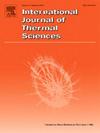Optimization design of integrated module for thermal management system in electric vehicle
IF 4.9
2区 工程技术
Q1 ENGINEERING, MECHANICAL
International Journal of Thermal Sciences
Pub Date : 2025-07-11
DOI:10.1016/j.ijthermalsci.2025.110141
引用次数: 0
Abstract
The temperature control of vehicle is achieved through thermal management system, the design of which is critical to regulating vehicle temperature and reducing energy consumption. In this study, an integrated coolant circulation module was developed. The internal flow dynamics of the module were simulated using the computational fluid dynamics K-ε turbulence model. The research objective was to investigate the correlation between pressure drop and coolant flow in different operational modes. The results reveal a nonlinear positive correlation between pressure loss and coolant volumetric flow rate. Through structural optimization in regions of high pressure difference within the flow field, the average pressure loss within the module was reduced by 37 %. The accuracy of the simulation was confirmed by rapid prototype testing on a test bench, followed by in-vehicle verification of the prototype. These validations demonstrate that the module meets design standards and effectively controls vehicle temperature. The implementation of the integrated module reduced the number of coolant pipelines in the thermal management system from 23 to 10, significantly decreasing the number of pipes and interfaces and thereby lowering the risk of coolant leakage. Additionally, it resulted in a 15.64 % reduction in material costs and a 354-s reduction in installation labor time. These improvements can significantly lower the production cost of the thermal management system of electric vehicle.
电动汽车热管理系统集成模块优化设计
汽车的温度控制是通过热管理系统来实现的,热管理系统的设计对于调节汽车温度,降低汽车能耗至关重要。在这项研究中,开发了一个集成的冷却剂循环模块。采用计算流体力学K-ε湍流模型对模块内部流动动力学进行了模拟。研究目的是探讨不同运行模式下压降与冷却剂流量之间的关系。结果表明,压力损失与冷却剂体积流量之间存在非线性正相关关系。通过对流场内高压差区域进行结构优化,使模组内平均压力损失降低37%。通过试验台快速样机试验验证了仿真的准确性,并对样机进行了车载验证。这些验证表明,该模块符合设计标准,并有效控制车辆温度。集成模块的实施将热管理系统中的冷却剂管道数量从23个减少到10个,大大减少了管道和接口的数量,从而降低了冷却剂泄漏的风险。此外,它还减少了15.64%的材料成本,减少了354秒的安装人工时间。这些改进可以显著降低电动汽车热管理系统的生产成本。
本文章由计算机程序翻译,如有差异,请以英文原文为准。
求助全文
约1分钟内获得全文
求助全文
来源期刊

International Journal of Thermal Sciences
工程技术-工程:机械
CiteScore
8.10
自引率
11.10%
发文量
531
审稿时长
55 days
期刊介绍:
The International Journal of Thermal Sciences is a journal devoted to the publication of fundamental studies on the physics of transfer processes in general, with an emphasis on thermal aspects and also applied research on various processes, energy systems and the environment. Articles are published in English and French, and are subject to peer review.
The fundamental subjects considered within the scope of the journal are:
* Heat and relevant mass transfer at all scales (nano, micro and macro) and in all types of material (heterogeneous, composites, biological,...) and fluid flow
* Forced, natural or mixed convection in reactive or non-reactive media
* Single or multi–phase fluid flow with or without phase change
* Near–and far–field radiative heat transfer
* Combined modes of heat transfer in complex systems (for example, plasmas, biological, geological,...)
* Multiscale modelling
The applied research topics include:
* Heat exchangers, heat pipes, cooling processes
* Transport phenomena taking place in industrial processes (chemical, food and agricultural, metallurgical, space and aeronautical, automobile industries)
* Nano–and micro–technology for energy, space, biosystems and devices
* Heat transport analysis in advanced systems
* Impact of energy–related processes on environment, and emerging energy systems
The study of thermophysical properties of materials and fluids, thermal measurement techniques, inverse methods, and the developments of experimental methods are within the scope of the International Journal of Thermal Sciences which also covers the modelling, and numerical methods applied to thermal transfer.
 求助内容:
求助内容: 应助结果提醒方式:
应助结果提醒方式:


